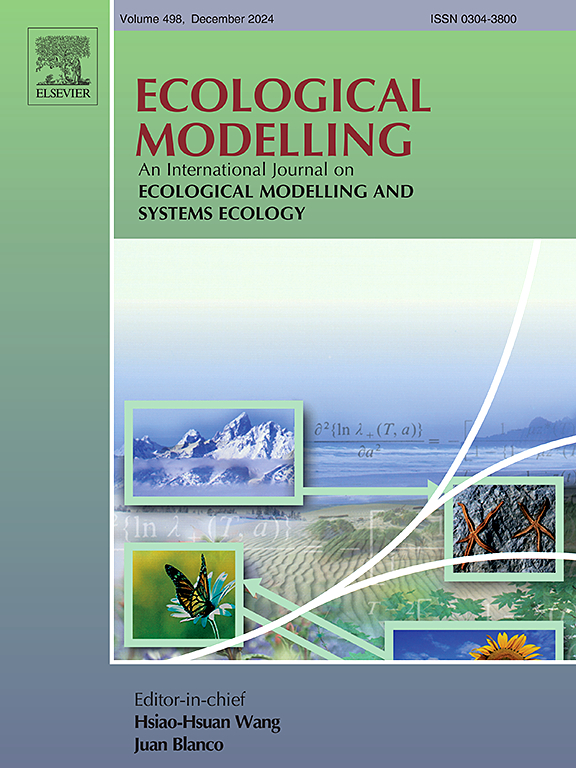Unified process model-based assessment of environmental interactions and ecosystem services of a managed fishpond-reed agroecosystem
IF 3.2
3区 环境科学与生态学
Q2 ECOLOGY
引用次数: 0
Abstract
To support better management of agroecosystems, this work presents a novel approach by considering a quantitative dynamic model-based and holistic background of environmental interactions. Recognizing the increasing importance of coupled systems in environmental management, the methodology is illustrated by a case study of a managed fishpond, partially covered by reed vegetation, and surrounded by reed beds. The unified elements of Programmable Process Structures (PPS) are used to analyze the underlying processes (physical, chemical, biological, ecological, technological, and managerial) and to determine the effects of management interventions on the environmental interactions of the fishpond agroecosystem. Simplified sub-process models have been implemented to calculate the dynamic environmental interactions of the example system studied. The sub-models exploit the approximate stoichiometries and causal relationships behind the environmental interactions with a transparent insight into the structured functionalities of the complex system. These features provide holistic model-based simulations from which the impacts of different management scenarios can be assessed. It is also discussed how the calculated quantitative environmental interactions can be used for a more rigorous assessment of ecosystem services (ES) and dis-services (EDS). It is concluded that many categories of ES (such as provisioning and regulatory services) can be derived directly from the quantitative environmental interactions. Other categories, such as habitat maintenance for biodiversity and cultural services, can be derived by combining the simulated quantitative data with expert-defined qualitative rules. The generalizable results and the reusable computational method outline the basis for a case-specific decision support tool based on a process model in further work.

基于统一过程模型的管理鱼塘芦苇农业生态系统环境相互作用和生态系统服务评价
为了支持更好的农业生态系统管理,这项工作提出了一种新的方法,通过考虑基于定量动态模型和环境相互作用的整体背景。认识到耦合系统在环境管理中的重要性日益增加,该方法通过一个管理鱼塘的案例研究来说明,该鱼塘部分被芦苇植被覆盖,并被芦苇床包围。可编程过程结构(PPS)的统一元素用于分析潜在的过程(物理、化学、生物、生态、技术和管理),并确定管理干预对鱼塘农业生态系统环境相互作用的影响。采用简化的子过程模型来计算所研究的实例系统的动态环境相互作用。子模型利用了环境相互作用背后的近似化学计量和因果关系,并对复杂系统的结构功能进行了透明的洞察。这些特性提供了基于模型的整体模拟,从中可以评估不同管理方案的影响。本文还讨论了计算的定量环境相互作用如何用于更严格的生态系统服务(ES)和非服务(EDS)评估。结论是,许多ES类别(如供应和监管服务)可以直接从定量的环境相互作用中导出。其他类别,如生物多样性生境维护和文化服务,可以通过将模拟的定量数据与专家定义的定性规则相结合而得出。可推广的结果和可重用的计算方法为进一步工作中基于流程模型的特定案例决策支持工具奠定了基础。
本文章由计算机程序翻译,如有差异,请以英文原文为准。
求助全文
约1分钟内获得全文
求助全文
来源期刊

Ecological Modelling
环境科学-生态学
CiteScore
5.60
自引率
6.50%
发文量
259
审稿时长
69 days
期刊介绍:
The journal is concerned with the use of mathematical models and systems analysis for the description of ecological processes and for the sustainable management of resources. Human activity and well-being are dependent on and integrated with the functioning of ecosystems and the services they provide. We aim to understand these basic ecosystem functions using mathematical and conceptual modelling, systems analysis, thermodynamics, computer simulations, and ecological theory. This leads to a preference for process-based models embedded in theory with explicit causative agents as opposed to strictly statistical or correlative descriptions. These modelling methods can be applied to a wide spectrum of issues ranging from basic ecology to human ecology to socio-ecological systems. The journal welcomes research articles, short communications, review articles, letters to the editor, book reviews, and other communications. The journal also supports the activities of the [International Society of Ecological Modelling (ISEM)](http://www.isemna.org/).
 求助内容:
求助内容: 应助结果提醒方式:
应助结果提醒方式:


